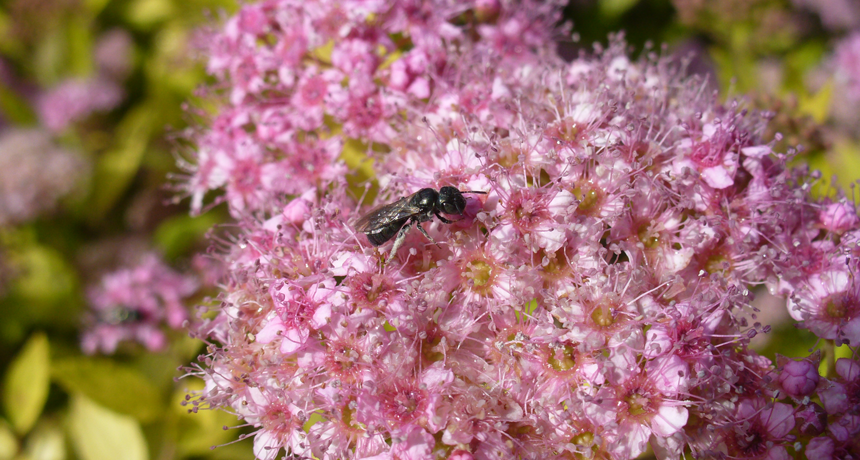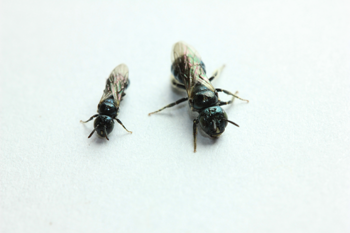Bee underfeeds eldest daughter, creating ‘nursemaid’
By limiting a firstborn female’s diet, these moms ensure those daughters stay small and take orders

A small carpenter bee (Ceratina calcarata) forages in a garden.
Molly Jacobson
Some small carpenter bees have a clever way of getting help with their domestic chores, such as raising their young. The mom forcibly turns her firstborn daughter into a maid and babysitter. The mom does this by underfeeding that eldest bee. This daughter not only gets small portions of food but also a diet especially low in protein, new research shows. And before long, this bee is the runt of her brood — and bullied by her mom.
In bees and some other insects, growth of the young largely depends on how much food they get. So, by tinkering with their diet, a mother can control her offspring’s size.
Small carpenter bees are a type of solitary insect. No hives for them. Adult females carve a tunnel into the dead, broken stem of a flowering plant. The bees don’t eat that chewed wood but throw it away. Inside her tunnel, a mom will fashion a comfy nest in which to lay eggs and nurture her young. Ceratina calcarata is a common species of small carpenter bee in eastern North America. Only about the size of an eraser at the top of a pencil, females of this species nest in spring.
To make her nest, a mom bee first hollows out a fallen plant stem. At the far, closed end of the tunnel, she stores away some food. She then lays her first egg atop it and builds a wall to seal the egg and its food into what’s known as a “brood cell.” Now she stashes another pile of food, lays another egg and seals up this cell. She repeats this over and over. Some nests have as many as 18 of these brood cells. As each egg hatches, the nestling begins chomping away at the food its mom had left behind.

But the mother bee does not provide for all of her offspring equally. She can control whether an egg will hatch into a boy or a girl. Boys don’t need as much to eat, so she rations their food supplies accordingly.
Sandra Rehan works at the University of New Hampshire in Durham. As an evolutionary biologist, she studies how group living evolved in insects. Her team’s new study finds that a mother bee can manipulate the behavior of her young by what and how much she feeds them.
The first-laid egg will usually hatch a female. Although mom will normally leave her daughters 24 milligrams (0.0008 ounce) of food on average, she leaves the first female less. It gets only around 20 milligrams. She leaves males the same amount. But since male carpenter bees are smaller than females, this food is plenty for them.
From previous work, scientists knew that the firstborn female received smaller morsels. But the new data reveal that her share of food is different in another way. It also has less protein than usual.
Rehan’s group published its findings August 15 in Behavioral Ecology and Sociobiology.
Diet control and bullying
Bee food is a mix of pollen and nectar. Pollen contains the male sperm cells of a plant. It is rich in proteins. The mother bee collects pollen from flowers nearby. Rehan’s team calculated the amount of protein in the pollen a mother bee had collected. They did this by sampling the food present in 71 brood cells from 9 nests of small carpenter bees.
On average, protein made up 6.5 milligrams of the diet supplied to the first female’s brood cell. The ninth female’s brood cell, in contrast, had about 9.3 milligrams of protein in its food.
Less protein in her already-small diet means the eldest daughter becomes a small-sized bee. Her younger female siblings instead grow into normal-sized adults. That means they are about 10 percent larger than their eldest sister — and the same size as their mother.
The mom uses her larger size and greater strength to get her undersized daughter to help out as a maid. She prompts this daughter to find food for her now-adult siblings by physically nudging her out of the nest.
“It’s like a head-butt,” explains Rehan. “They are not very aggressive bees. But for them, nudging is not a subtle cue,” she quips.
The mother bee had supplied food when she was building the nest. Then why does she force her eldest daughter to get her siblings even more food later on?
“The food provisioned to the eggs is enough for the [hatchlings] to develop into adults,” notes Rehan. But the food given to the adult bees by their sister allows them to survive through the winter, she says. During winter, small carpenter bees go into a long, deep slumber. It is similar to hibernation in larger animals. And during this time, those bees “really live off their fat stores,” says Rehan. Thus, by having the eldest daughter help feed the others, mom ensures her other offspring survive.
The adult bees wake up the next spring ready to leave the nest. These young males and females will go on to create families of their own. As for the eldest daughter, after all her hard work, she may not survive to spring.
The idea that mothers manipulate their daughters to be workers is not new, says Karen Kapheim. “But we are just beginning to piece together evidence for it,” she adds. Kapheim studies bees and their social behavior at Utah State University in Logan.
The original idea, Kapheim says, was that manipulation happens at the adult stage. It takes the form of aggression in moms toward worker daughters. Only recently have scientists started asking if there are other ways that moms may manipulate their offspring. And as this study shows, she notes, “One of the obvious places to look is larval [diets].”







